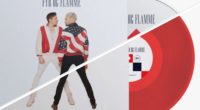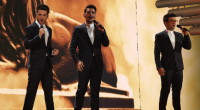
Seventeen songs, a tie, a tragic destiny and, believe it or not, computer chaos. That I met as I travelled back to the Danish final from 1979. This would be a show that in many ways showed how the Danish broadcaster still searched for the right format.
Imagine that you can travel back in time. What will you do? And what will you tell the people you meet about the future? As the curious Eurovision fan I am, I will go back to previous national finals. I want to see why my parents’ and grand parents’ generations voted as they did. I want to talk to the participants from back then, and I also want to follow the big developments happening within music and TV production.
After a succesful trip back to 1978, the time machine had now been set to the 3rd of February 1979. I was on the way to experience Dansk Melodi Grand Prix ’79. It was only the second year after Denmark’s return to Eurovision, and I knew I would find a show where the broadcaster was still experimenting and hadn’t yet found the right selection format.
In 1978, six songs competed. In 1979, that number was nearly tripled to seventeen. In ’78, DR had an open submission where anyone could submit their entry. In ’79, all songs came from composers specially invited due to their engagement in the Danish music scene in the 1970’s.
Contents
Greenland and Faroe Islands
For the first and only time, the entire Danish Kingdom was represented in the 1979 Danish final as Greenland and the Faroe Islands participated with one song each. To make it even more exotic, both countries sang in their own local languages.
The Danes are usually not exposed to Greenlandic or Faroese, so, for the TV viewers, these songs were probably hard to relate to. The titles of the songs were listed in Danish though. To give the two songs a fair chance, the juries had however been given a translation of the lyrics.
We will most likely never hear any of those languages in a Dansk Melodi Grand Prix again. As it is now, when a singer from either Greenland or the Faroe Islands is chosen, he or she will probably always sing in Danish or English due to tele voting. One might decide in the future to take a chance with Faroese, as, to Danes, this is more pleasant to the ears. Greenlandic however has nothing going for it in relation to appeal to the Danish viewers. Sorry, Greenland.
Seebach’s tragic destiny
As I stepped into the machine, Tommy Seebach was in my thoughts. Coming from the future, I of course knew that he, after a tie and a second round of voting, would be crowned the winner of this Danish final. I also knew that he would repeat this success just two years later and, again, in 1993. But, most importantly, I knew what personal tragedy was waiting for him. How much of that would I want to tell him? I was really in doubt.
I decided not to tell him anything. I didn’t tell him that I came from the future and knew what a glorious career was waiting for him. I didn’t tell him that we were to meet a couple of times more, that he would come to mean a lot to me. I didn’t mention any of that, as I didn’t want to tell him that he would become the entire nation’s scapegoat after a bad Eurovision result in ’93.
He wasn’t told either that I were to stand at his grave with a rose 25 years later. That he, at that point, had destroyed his own life with heavy alcohol abuse, which would affect everyone who knew him. As I hugged him after his victory this evening in 1979, he probably didn’t understand why I held on to him a little longer and why I would eventually let go with tears in my eyes. I couldn’t tell him why.
Mabel’s Saturday Show man
The previous year’s winning group Mabel were back for another attempt. The show had moved to DR’s own studios with a smaller audience. In contrast to the show in ’78, Mabel’s enormous fan scare, mainly consisting of teenage girls, weren’t present in the audience in such a big majority this year.
I don’t know if Tommy Seebach, or the other participants, paid attention to the lyrics of Mabel’s Saturday Show. The song tells the story of a man who used to be a big star, but, as time goes by, other names pop up and his career falls. All that is left for him now is just to perform at small bars where he uses every opportunity to tell people about the career he once had. That would be very appropriate for a couple of tonight’s participants.
Big career waiting for Kim Larsen
Just like in 1978, several of the participants this year were quite well known names. For some of them, success would be short, but, for others, it would continue in big style in the years and even decades to come. Kim Larsen in one of those in the last category.
Kim Larsen was, in 1979, just at the beginning of his solo career, but, since 1969, he had been lead singer in Denmark’s biggest rock band, Gasolin. They had split up in ’78, and Kim was now solo. After the result where he finished third with the song Ud I Det Blå, I rushed to tell him that, in the 80’s, he would become Denmark’s best selling artist and that you couldn’t find a household that didn’t have at least one of his albums. In 2017, his 1984 album Midt Om Natten would still be the best selling Danish album ever.
“Of course, that’s sounds right”, Kim Larsen reacted to the future I told him about. He was just as cocky as, when on stage in the live broadcast, he had commented on the result saying that now he would have to buy his own ticket to Israel. He took part in the hope of getting it for free! In Denmark, very few can get away with it, but his cockiness and his big mouth would become a big part of his success. Kim would speak his mind, and everyone would love it – just as much as they love his extremely catchy songs, which, in particular, the ’80’s and the ’90’s offered.
Watch the highlights
A video with all the highlights from this 1979 Dansk Melodi Grand Prix is available. It includes clips from all seventeen performing artists and a bit from the voting chaos where it ended in a draw. We have provided you with English subtitles directly on the video.
Did Denmark make the right choice?
In 1978, I was a bit in doubt if Denmark made the right choice. There were several other great songs that might have been able to deliver a good result at the Eurovision Song Contest.
As I leave the ’70’s this evening and return to 2017, it is with the knowledge that Tommy Seebach would finish sixth at the Eurovision Song Contest in Jerusalem. It is also with the confidence that the Danish jury did the right thing when they, in the second round of voting, picked Disco Tango. They basically had to choose between disco with a tango tune and swing pop. Disco was in at that time, swing wasn’t.
None of the sixteen other songs had potential to deliver a top 5 result at the Eurovision Song Contest that year in my opinion. So, yes, Denmark made the right choice.
Voting
That year, Denmark introduced the Eurovision voting with 12, 10 and 8 to 1 points in their national selection. Before it came to that, all 88 jury members, divided into eight juries, had awarded all songs with a score between one and five. These were then calculated into the Eurovision voting.
All jury members had been selected by a company that also did political forecasts. They were selected based on parametres such as age, gender, civil status and occupation.
Many Danes remember the 1979 Danish final for its computer chaos. A special voting headquarters had been established. In that, a computer was placed. All points coming in, and, from time to time, current standings, would be displayed on the computer and from there on TV. Given how few had computers back then, or even just sort of knew what it was, this was very much new technology to most. Maybe that’s why they, at some point during the show, had problems getting it to work.
| Artist | Rønne | Aalborg | Næstved | Aabenaa | Copenhagen | Holstebro | Odense | Århus | Points | Placing |
| Tommy Seebach | 8 | 10 | 8 | 12 | 12 | 12 | 8 | 12 | 82 | 1 |
| Grethe Ingmann and Bjarne Liller | 12 | 12 | 10 | 8 | 8 | 10 | 12 | 10 | 82 | 2 |
| Kim Larsen | 10 | 8 | 7 | 10 | 6 | 8 | 3 | 4 | 56 | 3 |
| Annika Hoydal | 3 | 5 | 12 | 6 | 10 | 7 | 5 | 7 | 55 | 4 |
| Mabel | 5 | 0 | 4 | 4 | 5 | 6 | 10 | 5 | 39 | 5 |
| Pia and Ina Rosenbaum | 4 | 2 | 6 | 7 | 3 | 1 | 7 | 8 | 38 | 6 |
| Lecia og Lucienne | 7 | 6 | 1 | 5 | 7 | 4 | 4 | 3 | 37 | 7 |
| Brødrene Olsen | 6 | 7 | 3 | 3 | 0 | 5 | 6 | 2 | 32 | 8 |
| Thorstein Thomsen and Pia Dalsgaard | 1 | 3 | 5 | 0 | 2 | 2 | 0 | 6 | 19 | 9 |
| Allan Mortensen | 2 | 4 | 2 | 2 | 1 | 0 | 2 | 0 | 13 | 10 |
| Rasmus Lyberth | 0 | 0 | 0 | 0 | 4 | 3 | 0 | 0 | 7 | 11 |
| Tamra Rosanes | 0 | 0 | 0 | 0 | 0 | 0 | 1 | 1 | 2 | 12 |
| Nis P. Jørgensen | 0 | 1 | 0 | 0 | 0 | 0 | 0 | 0 | 1 | 13 |
| Jannie Høeg | 0 | 0 | 0 | 1 | 0 | 0 | 0 | 0 | 1 | 13 |
| Anette Toft | 0 | 0 | 0 | 0 | 0 | 0 | 0 | 0 | 0 | 15 |
| Mona Larsen | 0 | 0 | 0 | 0 | 0 | 0 | 0 | 0 | 0 | 15 |
| Pierre Dørge | 0 | 0 | 0 | 0 | 0 | 0 | 0 | 0 | 0 | 15 |
In the second round of voting, Tommy Seebach received 51 points. Grethe Ingmann and Bjarne Lille 36 points. One jury member got sick and didn’t vote.
This reflection article is based on the author's own personal experience. Views expressed belongs to him or her, and are to be seen as unrelated to EuroVisionary.com.




















